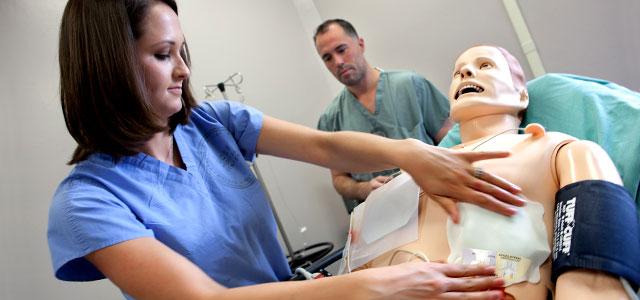
Nursing doctoral student Rich Fidler observes an internal medicine resident practicing in the San Francisco VA Medical Center's Simulation Center (photos by Elisabeth Fall).
Improving Cardiac Care with the Science of Human Use
Few people grasp the intimate relationship between machines and humans quite like the clinicians of a cardiac critical care or emergency unit. There, nurses, doctors and technicians use an assortment of highly advanced equipment to monitor even the subtlest cardiac rhythms, and to zap and pump frail and failing hearts to life. These electrocardiograms (ECGs), defibrillators and other devices are mainstays of modern cardiac care.
Rich Fidler, a critical care nurse practitioner, nurse anesthetist and graduate student at UC San Francisco School of Nursing, is on a mission to improve the “human factor” or real-life usability of this equipment and, in doing so, to reduce medical errors. Fidler’s drive is fueled by his long history of not only using cardiac equipment to care for patients, but also teaching its use to others.
Through rigorous testing, Fidler aims to help manufacturers understand and better design their equipment for use by those who may be tall or short, athletically strong or couch-potato weak, nimble-fingered or a little stiff.
“The big question is how to make performance uniform and consistent without regard to the person using the device,” Fidler says.
His work is attracting the interest he’d hoped.
A recent study at five California Veterans Affairs (VA) hospitals compared the clinical use of three brands of defibrillators in mock code-blue situations using human factors analysis.
“He presented this project at the American Heart Association’s recent annual Scientific Sessions and was inundated with interested parties, from the FDA [Food and Drug Administration], the NHLBI [National Heart, Lung, and Blood Institute] and a slew of other investigators interested in resuscitation science,” said School of Nursing professor Barbara Drew, Fidler’s PhD advisor and mentor, whose cardiac monitoring research is world-renowned.
Not a Typical Graduate Student
Fidler’s academic interests are driven by his full-time job at the San Francisco VA Medical Center, where today he works as a nurse anesthetist and directs its Simulation Center. In the past, Fidler, 43, has also worked as a certified nurse practitioner in critical care, adult medicine and geriatrics; he also holds an MBA and is the first to admit that his career path is unusual. But for him, the demanding job and demanding academic pursuits meld perfectly.
One clear example is the comparison study on the defibrillators. It came about because he was asked to oversee the purchasing of that equipment for the VA.
“He decided he’d collect data to decide which one is best,” says Drew. “Most hospitals don’t do that; they just look at the price. They don’t try it out first with the people who are going to use it, and find out if it’s easy to use.”
Similarly, Fidler’s PhD project examines new ways of placing ECG electrodes on the body to maximize heart-monitoring effectiveness and minimize false alarms, which can cause alarm fatigue – an increasing concern nationwide.
“My clinical practice drives every research question I’ve ever had,” Fidler says. “I’m trying to make the hospital a safer place: If you have a cardiac arrest, how do I make it more likely that you’ll live?”
Applying Lessons from Real-World Hospital Care
Working with patients on a regular basis not only provides the special satisfaction that comes from direct care, but also keeps Fidler exposed to the moment-by-moment pace of a busy hospital.
He brings this perspective to the Simulation Center, where he trains doctors, nurses, pharmacists, respiratory therapists and other VA staff using technologically advanced mannequins that respond like actual patients to simulated clinical procedures.
“I plunk down the mannequins – they’re very, very lifelike – and hook them up to the monitors. They’ll sweat, they’ll cry, they’ll bleed, they’ll clench their jaw, they’ll turn blue,” Fidler says. “They won’t respond unless you do something to them, like shock the arrhythmia with real electricity.”
Through these trainings, Fidler keenly observes the interactions of users with the machinery and the mannequins, soliciting detailed feedback along the way.
Small things catch his eye: how fingers and eyes search for smaller buttons, or how those with muscular builds have an easier time whisking heavier machines across the floor.
“I’ve got highly educated health care professionals walking up to a piece of highly technical equipment, and I want it to be used as intuitively as possible – quickly, safely and correctly,” Fidler says. “And there are considerable differences in these human factors that affect performance.”
While it’s true that all medical equipment must meet strict operating standards set by the FDA, “There are often unintended features about the technology that may make sense to the engineers but can be confusing or misleading to the clinical staff who apply it to patients,” says Drew.
The Power of Research “Cred”
For years Fidler shared his observations about equipment use with manufacturers, suggesting modifications. “But no one was really listening,” he says. “That’s when I realized I needed a PhD. Without research, I couldn’t really make my point.”
Using the VA’s in-the-trenches employees and simulation lab, he’s making haste to back up his observations with solid research.
His VA defibrillator study, which is in review for publication, identified the difficulty people had locating buttons colored the same as the background, and the confusion caused by multifunction knobs and labeling. It also notes positives: easy-to-operate large knobs, handy bed rails and straightforward, intuitive operation.
In another project, Fidler is adapting the Swedish-designed LUCAS, a chest compression machine used mainly in ambulances, for hospital settings.
“Next thing I know, the company that built the thing is contacting me; I get a phone call from a fellow with a thick Swedish accent saying he’d like to have his design team meet with my team,” Fidler says. And they did.
“The health care community needs clinicians like Rich Fidler who have amassed the necessary hours in hands-on use of medical devices to step up and carry the banner for thoughtful, comprehensive and insightful usability testing,” said Luke A. Petosa, director of the Center for Education and Training at ECRI Institute, a nonprofit promoting the scientific testing of medical equipment, devices and drugs and a designated Evidence-Based Practice Center by the Agency for Healthcare Research and Quality, a division of the US Department of Health and Human Services.
“The inherent limitations of the human senses and working memory, particularly in light of the environmental stressors our clinicians are subject to every day, make the work of Mr. Fidler even more timely and impacting,” says Petosa.
Despite the praise and successes, Fidler is quick to squelch any notions that he’s headed for a next-step career in equipment R & D. The reasons he became a nurse fuel him as much today as they did when he started out, he says, including the connection with patients.
This is why he rarely tells people that he also has an MBA. He enjoys certain aspects of administration but doesn’t want to be pigeonholed into the business end of health care.
“I’ll never give up my clinical practice – ever. What I do for patients has never changed. I enjoy when patients tell me their problems, and I can go back to them and say, ‘Here’s what I can do for you,’” says Fidler. “Every role I do, every time I get a new skill set, I have one more thing to offer.”



